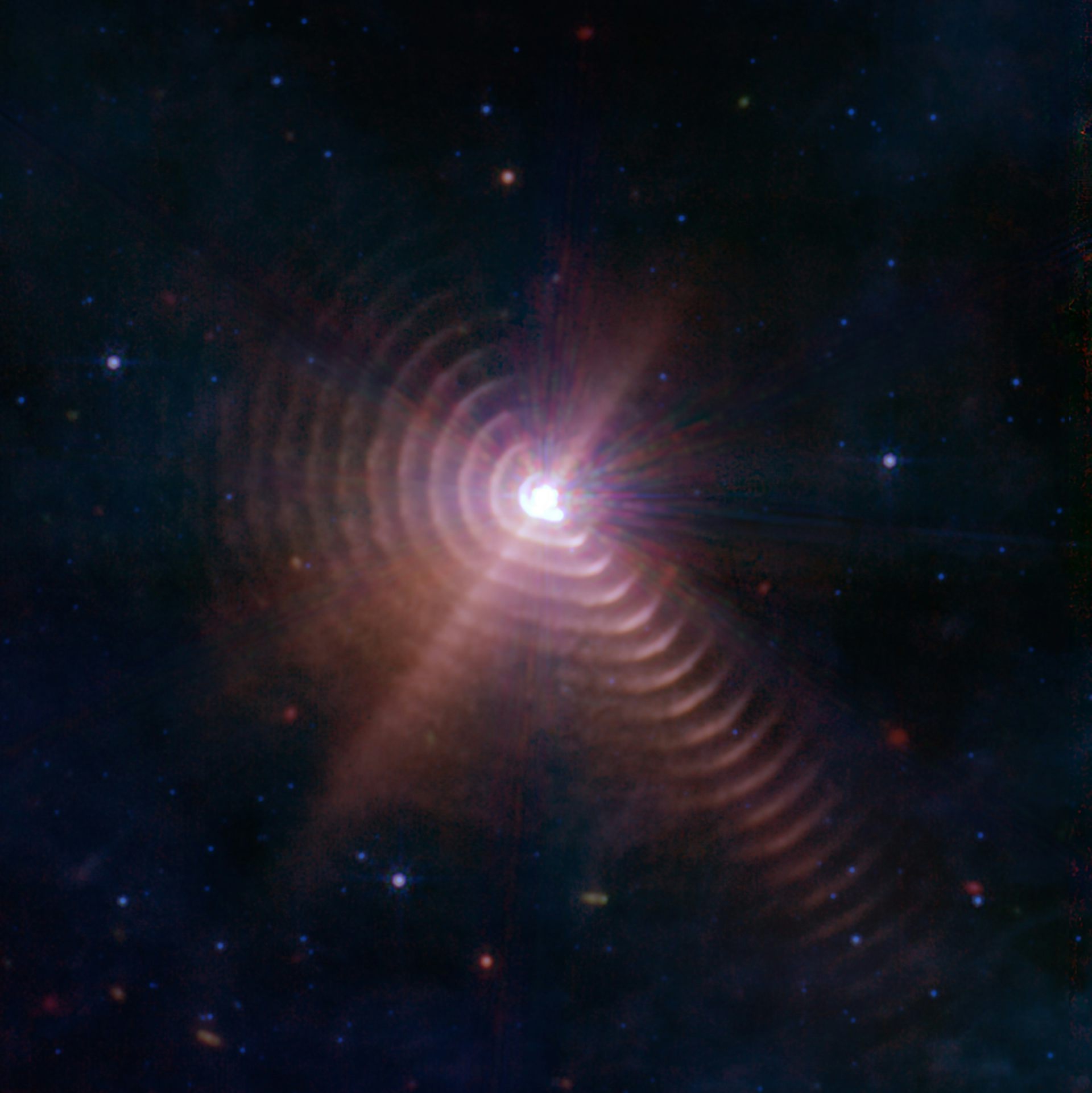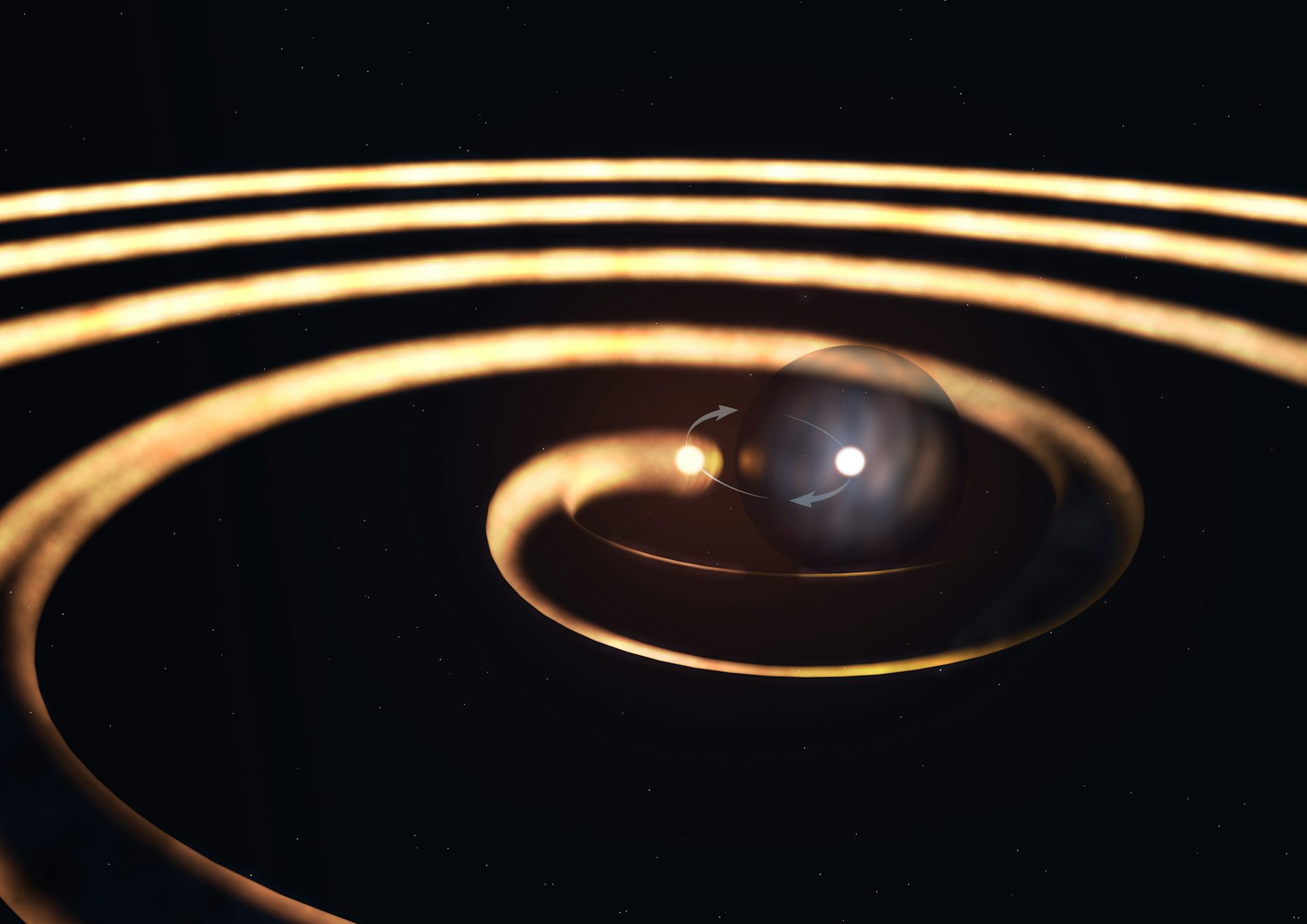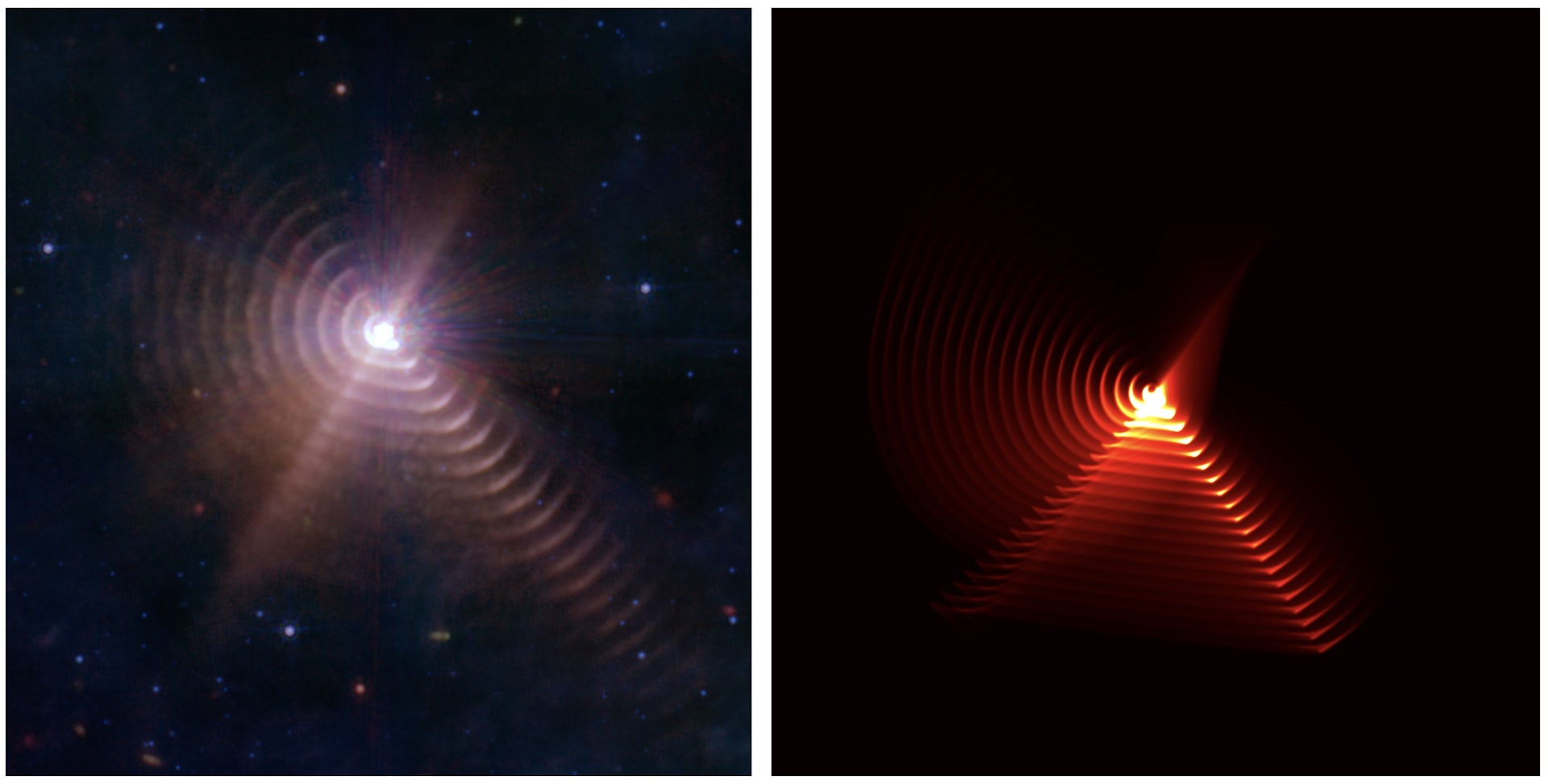
An alien magastructure?
Surely there must be an intelligence behind such an ordered structure! Read on!
Surely there must be an intelligence behind such an ordered structure! Read on!
Left: false-colour JWST/MIRI Imager observations of WR 140 taken with the F770W, F1500W and F2100W filters that correspond to blue, green and red, respectively. Eight symmetric diffraction spikes are seen around the saturated core of WR 140 (at the origin) that exhibit bluer colours than the dust emission. Right: JWST/MIRI MRS spectral data cube images of WR 140 from Channel 2 at 8.01 μm taken at two different positions that cover the central binary and shell 1 (Offset 1, top) and shells 1 and 2 (Offset 2, bottom) shown in a square-root stretch. The central binary and bright dust emission features are labelled in the MRS data cube images.
One of the Creationist cult's articles of faith is the demonstrably false assertion that you can't get order from chaos, although how they imagine raindrops form, or even more subtly, how an internal combustion engine works without the operation of the gas laws which are emergent laws from the chaotic mass action of gas molecules, is anyone's guess.
A moment's thought should tell them that, with a directional force involved, there can be no such thing as true randomness in nature. One such force is of course gravity which turns a cloud of randomly distributed gas particles into an ordered sun and maybe a planetary system. Another example is the process of natural selection which gives a non-random progress towards assorted genes in a species from the random occurrence of genetic mutations.
And here is yet another example of structure emerging naturally from chaotic dust particles in an article from The Conversation by Professor Peter Tuthill, an Astrophysicist at the University of Sydney, NSW, Australia. The article is reproduced here under a Creative Commons license, reformatted for stylistic consistency. The force in this instance is the complex pattern of gravity generated by two stars in elliptical orbit around each other in a binary system and the intense solar winds each gives off which drives regular pulses of dust from their surfaces.
The original article can be read here:

Alien megastructures? Cosmic thumbprint? What’s behind a James Webb telescope photo that had even astronomers stumped

Credit: NASA / ESA / CSA / STScI / JPL / Caltech
The internet immediately lit up with theories and speculation. Some on the wild fringe even claimed it as evidence for “alien megastructures” of unknown origin.
Luckily, our team at the University of Sydney had already been studying this very star, known as WR140, for more than 20 years – so we were in prime position to use physics to interpret what we were seeing.
Our model, published in Nature, explains the strange process by which the star produces the dazzling pattern of rings seen in the Webb image (itself now published in Nature Astronomy).
The secrets of WR140
WR140 is what’s called a Wolf-Rayet star. These are among the most extreme stars known. In a rare but beautiful display, they can sometimes emit a plume of dust into space stretching hundreds of times the size of our entire Solar System.
The radiation field around Wolf-Rayets is so intense, dust and wind are swept outwards at thousands of kilometres per second, or about 1% the speed of light. While all stars have stellar winds, these overachievers drive something more like a stellar hurricane.
Critically, this wind contains elements such as carbon that stream out to form dust.
WR140 is one of a few dusty Wolf-Rayet stars found in a binary system. It is in orbit with another star, which is itself a massive blue supergiant with a ferocious wind of its own.

The binary stars of the WR140 system.
Credit: Amanda Smith / IoA / University of Cambridge, Author provided
Because the binary star is in constant orbital motion, this shock front must also rotate. The sooty plume then naturally gets wrapped into a spiral, in the same way as the jet from a rotating garden sprinkler.
WR140, however, has a few more tricks up its sleeve layering more rich complexity into its showy display. The two stars are not on circular but elliptical orbits, and furthermore dust production turns on and off episodically as the binary nears and departs the point of closest approach.
Whenever WR140 and its binary companion star are close enough together, a pulse of dust streams into space.
By modelling all these effects into the three-dimensional geometry of the dust plume, our team tracked the location of dust features in three-dimensional space.
By carefully tagging images of the expanding flow taken at the Keck Observatory in Hawaii, one of the world’s largest optical telescopes, we found our model of the expanding flow fit the data almost perfectly.
Except for one niggle. Close in right near the star, the dust was not where it was supposed to be. Chasing that minor misfit turned out to lead us right to a phenomenon never before caught on camera.
The power of light
We know that light carries momentum, which means it can exert a push on matter known as radiation pressure. The outcome of this phenomenon, in the form of matter coasting at high speed around the cosmos, is evident everywhere.
But it has been a remarkably difficult process to catch in the act. The force fades quickly with distance, so to see material being accelerated you need to track very accurately the movement of matter in a strong radiation field.
This acceleration turned out to be the one missing element in the models for WR140. Our data did not fit because the expansion speed wasn’t constant: the dust was getting a boost from radiation pressure.
Catching that for the first time on camera was something new. In each orbit, it is as if the star unfurls a giant sail made of dust. When it catches the intense radiation streaming from the star, like a yacht catching a gust, the dusty sail makes a sudden leap forward.
Smoke rings in space
The final outcome of all this physics is arrestingly beautiful. Like a clockwork toy, WR140 puffs out precisely sculpted smoke rings with every eight-year orbit.
Each ring is engraved with all this wonderful physics written in the detail of its form. All we have to do is wait and the expanding wind inflates the dust shell like a balloon until it is big enough for our telescopes to image.

In each eight-year orbit, a new ring of dust forms around WR140.
Credit: Yinuo Han / University of Cambridge, Author provided
Then, eight years later, the binary returns in its orbit and another shell appears identical to the one before, growing inside the bubble of its predecessor. Shells keep accumulating like a ghostly set of giant nesting dolls.
However, the true extent to which we had hit on the right geometry to explain this intriguing star system was not brought home to us until the new Webb image arrived in June.

The image from the James Webb Space Telescope (left) confirmed in detail the predictions of the model (right).
Credit: Yinhuo Han / Peter Tuthill / Ryan Lau, Author provided
Here were not one or two, but more than 17 exquisitely sculpted shells, each one a nearly exact replica nested within the one preceding it. That means the oldest, outermost shell visible in the Webb image must have been launched about 150 years before the newest shell, which is still in its infancy and accelerating away from the luminous pair of stars driving the physics at the heart of the system.
With their spectacular plumes and wild fireworks, the Wolf-Rayets have delivered one of the most intriguing and intricately patterned images to have been released by the new Webb telescope.
This was one of the first images taken by Webb. Astronomers are all on the edge of our seats, waiting for what new wonders this observatory will beam down to us.
Peter Tuthill, Astrophysicist, University of Sydney
In the abstract to their open access paper published in Nature Professor Tuthill's team give more technical details:
Abstract
The Wolf–Rayet (WR) binary system WR140 is a close (0.9–16.7 mas; ref.1) binary star consisting of an O5 primary and WC7 companion2 and is known as the archetype of episodic dust-producing WRs. Dust in WR binaries is known to form in a confined stream originating from the collision of the two stellar winds, with orbital motion of the binary sculpting the large-scale dust structure into arcs as dust is swept radially outwards. It is understood that sensitive conditions required for dust production in WR140 are only met around periastron when the two stars are sufficiently close2,3,4. Here we present multiepoch imagery of the circumstellar dust shell of WR140. We constructed geometric models that closely trace the expansion of the intricately structured dust plume, showing that complex effects induced by orbital modulation may result in a ‘Goldilocks zone’ for dust production. We find that the expansion of the dust plume cannot be reproduced under the assumption of a simple uniform-speed outflow, finding instead the dust to be accelerating. This constitutes a direct kinematic record of dust motion under acceleration by radiation pressure and further highlights the complexity of the physical conditions in colliding-wind binaries.
Han, Y., Tuthill, P.G., Lau, R.M. et al.
Radiation-driven acceleration in the expanding WR140 dust shell.
Nature 610, 269–272 (2022). DOI: 10.1038/s41586-022-05155-5
Copyright: © 2022 The authors.
Published by Springer Nature Ltd. Open access
Reprinted under a Creative Commons Attribution 4.0 International license (CC BY 4.0)
It will be interesting to see, if any creationist fraud has the courage to deal with this phenomenon, how they manage to maintain the fiction that order can't come from chaos without god-magic, despite the abundant examples, such as this one, of order emerging from chaos under nothing more than the operation of natural forces with no supernatural entities required to explain it.
But then creationists are used to having these god-filled gaps closed by science with no god found so they should be used to dismissing reality and ploughing on regardless, relying on their scientifically illiterate dupes being unaware of the science refuting their claims.


No comments :
Post a Comment
Obscene, threatening or obnoxious messages, preaching, abuse and spam will be removed, as will anything by known Internet trolls and stalkers, by known sock-puppet accounts and anything not connected with the post,
A claim made without evidence can be dismissed without evidence. Remember: your opinion is not an established fact unless corroborated.